Getting started with recording can be daunting. On the one hand, there’s a wonderful variety of devices to help you get great results at costs hardly imaginable just two decades ago. On the other hand, that same saturated market can make it difficult to know where to start. This is particularly true for microphones, especially the large diaphragm condensers (LDC) typically utilized for vocal recording.
LDC mics tend to be one of the first pieces purchased for any type of home recording, and manufacturers see it as a crucial entry point for new DIY home studio enthusiasts. This is part of the reason the sub-$250 condenser mic market has become a saturated, dizzying spread of options. To help sort through the noise, we’ve rounded up some of the best in class. From mod-friendly mics for the DIY hobbyist to the best out-of-the-box performers, we’ll help you find the right mic to get great results on a working man’s budget.
Rode NT1-A
A standard in home studios for two decades - exceptionally low self-noise and balanced tonality.
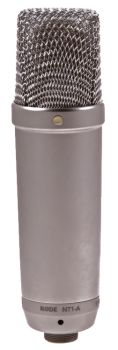
First up, we have the Rode NT1A. This mic has been a staple of the home recording scene for almost two decades. Better yet, it has only improved over time, as the good folks at Rode continue to make improvements to its frequency response and impressively low self-noise. As any research into this mic will make quickly apparent, it is super quiet. This is important for home recording where there are typically many other sources of noise to contend with. The NT1A's mere 5dbA of self-noise means you can crank the gain on your preamp way up and softly record that latest song idea in the middle of the night without waking up any roommates or neighbors. You'll still have negligible noise floor to contend with - a feat some of the other mics on this list might struggle with. With its ultra quiet operation and balanced frequency response, it's hard to get it wrong with the Rode NT1A even if you're new to recording.
The newest version is also available bundled with a Rycote Lyre shockmount and advanced pop filter, offering the highest possible quality of two essential mic accoutrements. Just grab a stand for the mic and you're ready to go. As one of the most popular first mics in the world, there's a big used market as well, so check out the listings on Reverb, grab one of your own and get recording.
CAD M179
Continuously variable pickup patterns and a smoother top end make the M179 the most versatile contender on this list.
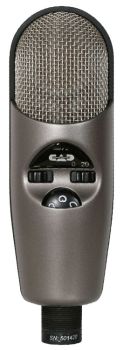
This mic is like a swiss army knife for your studio. Unlike the other mics on this list, which have a fixed cardioid pickup pattern (ideal for recording a single, front-facing source like a singer), the M179 features variable pickup patterns you can adjust from a dial on the front. This means you can expand to a figure 8, allowing you to try out stereo techniques like recording two singers facing each other at the same time, or omni, which picks up all directions equally - great for recording a group or getting room tone.
While this is definitely a great mic for vocals or acoustic instruments, this also tops several pro's lists of favorite mics for toms. This is mostly due to having a rounder top end than a lot of lower-cost condenser mics, with a lower frequency presence boost. This is also useful if you'll be recording a vocalist that tends to be harsh or sibilant on other mics. If your plans include recording a variety of instruments in addition to vocals, this mic is one you definitely want to consider.
Blue Spark
Space-age design with a sound as bright and poppy as its citrus paint job.

One of the most unique looking microphones to debut in recent years, the Blue Spark isn't all flash and includes some innovative features to complement its retro-futurist aesthetic. Chief among these is the 'Focus' button, which transforms the mic's relatively neutral tone and gives it a more colored frequency response. On vocals this adds more air and presence and cuts some low-end. It's a great tool for helping a pop vocal cut through dense modern production.
It has a smaller diaphragm (the capsule element that actually transfers the sound waves from the source into electrical signals) than the other mics on the list. The Spark falls into the medium diaphragm category, where most vocal-specific mics use a large diaphragm. This pushes the Spark towards a brighter, hyped tonality, which can be an asset when dealing with darker voices. It's gained many fans among baritone voiced podcasters and voiceover artists for its ability to cut out mud and add clarity without the need for additional EQ. Many rap artists and producers have also lauded the mic for its crisp tonality on male voices, which helps the vocals sit ‘on top of' the track as is often desirable in a hip-hop mix. If head-turning looks and a bright, modern sound are what you're after, then the Blue Spark is the choice for you.
RELATED ARTICLE
sE X1
A solid all-around performer with a best in class starter bundle to get you up and recording quickly.
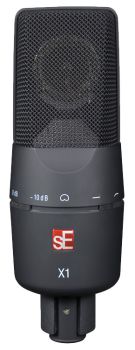
sE is one of the newer kids on the block in the mic maker's world, but they've been making a big splash since hitting the scene in the early 2000s. The X1 in particular has gained many accolades for its incredible performance for the price. Its head-turning matte black rubberized finish hasn't hurt either. The finish is functional, too, reducing vibrations to the interior components and capsule. Sound is the most important aspect, of course, and the X1 shines there as well. It has been favorably compared to some of the stalwarts at this price point, including the NT1A. Head-to-head with that mic, the X1 has a sound that is a little brighter, with a more pronounced presence peak. This is something to consider if you're planning to record a darker voice or one more sibilant and bright. Similar to the NT1A, though, the X1 is a great performer on a variety of sources and serves as an excellent workhorse mic.
Best of all, this mic is available in one of the most complete starter bundles around, including a high-quality shockmount, proper metal windscreen and even a rear reflection panel. These acoustic panels mount behind the mic and absorb much of the source signal before it can reflect off the walls and other surrounding surfaces and get back to the front pickup area of the mic, drastically reducing room tone and flutter echo from untreated spaces like bedroom studios. This all-in-one package is an awesome way to get great results quickly. If you are recording in a regular room in your house (not a dedicated studio room), definitely give the sE X1 Studio Package a close look.
MXL 990
Super cheap and eminently moddable for the DIY lover.
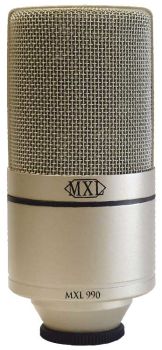
If you're more the DIY type, then this is the entry for you. This mic makes the list not necessarily for its sterling qualities out of the box, but for its potent pairing of supreme affordability and maximum modification potential. In the used market, you can pick up a 990 for as low as $50, with a myriad of modification options in the $100-$150 range are available. Ultimately, this allows you to end up with a mic that can go toe-to-toe with one of the all-time great vocal mics, like the Neumann U87, for about a tenth of the price.
Whether it's installing a more open headbasket, swapping out the capsule, breaking out the soldering iron to implement an improved circuit board, or all of the above, there are a ton of resources to help you turn the humble 990 into a world class mic on the cheap, and as a bonus you are sure to learn a lot in the process.
AKG Perception 220
Shockingly well-made for its price, the Perception 220 balances high frequency detail and smoothness in a way most mics at this price point can't.
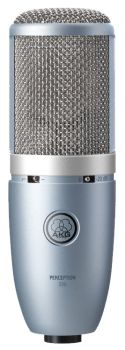
Lastly, for out of the box performance on vocals - the Perception 220 is our top pick. It has won numerous shootouts against almost every mic at this price point. Clear and detailed, but with an impressive amount of warmth, the Perception 220 is easily one of the best in its class. For decades AKG has been known for great mics and headphones, including some all-time classics costing thousands of dollars. It's clear that the Perception 220 has clearly benefited from all those years of research and development.
The Perception 220 mirrors the design of what many pros consider the greatest vocal mic of all time - the Neumann’s U87 - almost exactly. Most importantly, it includes the crucial corrective EQ circuit left out of many lower-cost mics also chasing the U87 design. This EQ is necessary to keep a U87-style mic from sounding overly bright, a problem found in most low cost condensers. Not just for vocals, it sounds great on huge variety of sources, especially acoustic guitar and cymbal overheads. It has fantastic high end detail without the all-too-common harshness of cheap condensers. For a singer-songwriter, rapper or a producer looking to tackle a variety of vocalists, the Perception 220 is a mic you should put at the top of your wishlist.

